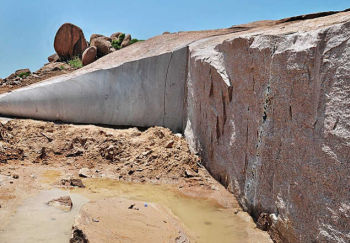
Mohamed Imranullah S.POLISHED OFF:A part of the hillock gone for ever owing to stone quarrying at Arittapatti in Madurai district. — Photo: S. James
from The Hindu
MADURAI: The Madras High Court Bench here on Thursday stayed the operation of a Government Order (G.O.) passed by the Industries Department on September 19, 2008, permitting Tamil Nadu Minerals Limited (TAMIN), a State government undertaking, to quarry stones from 47.37 hectares of ‘poromboke’ land situated near a hillock, housing ancient Jain abodes and Tamil Brahmi inscriptions, at Arittapatti in Melur taluk in Madurai district.
A Division Bench comprising Justice K. Suguna and Justice A. Arumughaswamy granted the interim stay pursuant to a public interest litigation petition filed by K. Selvaraj, a resident of the village, through his counsel R. Venkatesan.
The judges also ordered notices to the Union Ministry of Environment and Forests, the State government, Commissioner of Archaeology Department, Department of Geology and Mines and others returnable by ten weeks.
The petitioner claimed that the hillock in his village contained Brahmi inscriptions dating back to third century B.C. These inscriptions were believed to be of Buddhist origin indicating the prevalence of Buddhism in these parts at that point of time.
According to some historians, Emperor Ashoka and his son Mahinda had introduced Buddhism in this region, assisted by Maha Aritta, nephew of Sri Lankan King Tissa, who was believed to have stayed in the caverns in Arittapatti hillock. “These inscriptions in Madurai are the oldest records of written language in Tamil. The entire hillock is an ancient monument. A rare inscription found in Arittapatti recently has brought to light the fact that not only Pandyas and Cheras but the chiefs of the coastal regions in the State had also patronised Jainism. The discovery by a team of epigraphists is a remarkable evidence of history of early Tamil politics, culture and language,” the petitioner’s affidavit read.
Pointing out that the Jain caverns in Arittapatti hillock had been declared as protected monuments under the Ancient Monuments and Archaeological Sites and Remains Act, 1958, the petitioner said that permitting stone quarrying near the hillock might pose a threat to those monuments. He urged the court to quash the 2008-G.O. and issue a direction to the State and Central governments to protect the hillock on the basis of suggestions received from experts in the field of archaeology.
Sourse:Buddhist Art News

No comments:
Post a Comment